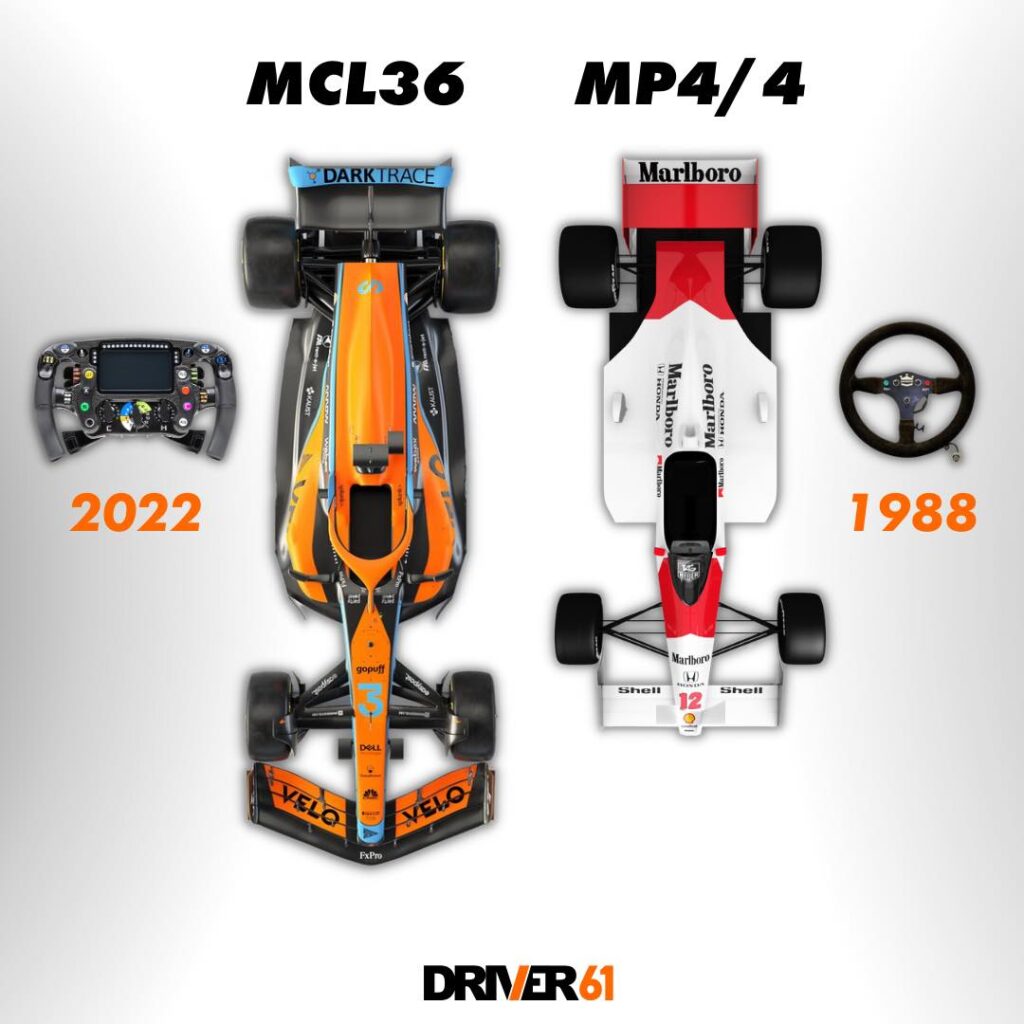The dimensions of a Formula 1 car are critical to its performance, with length playing a significant role in the vehicle’s aerodynamic profile and handling characteristics. Modern F1 cars are marvels of engineering, designed to comply with strict regulations that govern their dimensions. While there is no maximum length set by the regulations, practical design constraints and aerodynamic considerations indirectly limit the length of these vehicles. Typically, an F1 car is around 5.7 meters in length and 2 meters in width.
These high-tech machines are the focal point of the sport, with teams pouring extensive resources into optimizing every aspect of the car’s design to extract the maximum performance. The length of the car can influence its speed, stability, and maneuverability on the track.
Throughout the history of Formula 1, the evolution of car dimensions has been shaped by both technological advancements and changes in regulations aimed at ensuring competition and safety.
Key Takeaways
- F1 car dimensions are crucial for aerodynamics and handling.
- Modern F1 vehicles harmonize advanced engineering with regulatory compliance.
- Design evolution is driven by performance optimization and safety standards.
Historical Evolution of F1 Car Length
The lengths of Formula 1 cars have been subject to extensive regulation changes, particularly during the transition from 2021 to 2022. These changes highlight the sport’s focus on innovation and adaptation to new standards, significantly impacting the design strategies of the teams.
Transition from 2021 to 2022 Regulations
In 2021, Formula 1 cars were typically around 189 inches (4,800 mm) in length. With the 2022 season came a set of new regulations aimed at improving competition and performance. Amongst other changes, these regulations affected the overall length of the cars. Despite an absence of a specific maximum length being prescribed in the new regulations, the changes in aerodynamics and tire size inevitably pushed teams to modify their designs, with most 2022 cars being longer than their predecessors by several inches.
Historic F1 Cars
The evolution of Formula 1 car length is a testament to the sport’s constant state of flux driven by technological advancement and regulatory shifts. For example, in the last decade alone, from 2011 to 2021, the length of F1 cars saw an increase from 189 inches (4,800 mm) to beyond 197 inches (5,000 mm). This shift was reflective of various factors, including aerodynamic design and safety improvements. The comparison of these figures over time illustrates Formula 1’s relentless pursuit of development:

- 2011: 189 inches (4,800 mm)
- 2021: Over 197 inches (5,000 mm)
- 2023: Up to 222.4 inches (5,650 mm)
Each phase in the history of Formula 1 cars showcases the sport’s drive for innovation, with car dimensions as a considerable aspect of a team’s strategy and performance.
F1 Car Dimensions Explained
In Formula 1, car dimensions are critical factors that determine design, operational space, and aerodynamic efficiency. Each aspect of an F1 car’s dimensions, including length, width, and height, is carefully regulated and strategically designed to maximize performance on the track.
Importance of Car Length
The length of a Formula 1 car is a significant design consideration as it affects both the aerodynamics and the space available for onboard components. Present regulations allow for these cars to have a maximum length of approximately 5.7 meters—longer than most family cars. A longer chassis provides more surface area for aerodynamic components, which can enhance stability and speed, but also creates challenges in maneuverability and weight distribution.
Impact on Aerodynamics
Aerodynamic performance is paramount in Formula 1, where even small changes in car dimensions can have a large impact on lap times. A longer car might allow for smoother airflow and increased downforce, improving cornering and acceleration. Conversely, managing the airflow over a longer body requires precise engineering to prevent drag that can reduce top speeds.
Width and Height Regulations
Width and height are essential elements of F1 car dimensions, governed by strict regulations to ensure fairness and safety. Current width must not exceed 2 meters, while height is typically around 95 centimeters. These dimensions are crucial for aerodynamic performance, influencing factors such as the car’s center of gravity and its ability to cut through the air efficiently. Height also affects the vehicle’s overall stability, especially at high speeds.
Design and Technical Specifications

In Formula 1 racing, a car’s length is a crucial aspect of its design and technical specifications, which in turn are heavily influenced by engine size, aerodynamic components, and the weight and materials used in its construction.
Influence of Engine Size
The size of the engine in a Formula 1 car has a direct impact on the vehicle’s overall length. Modern F1 cars use a 1.6-liter turbocharged V6 engine, with tight regulations surrounding its size and placement within the chassis. This compact power unit allows for more flexibility in the car’s design, especially in terms of the aerodynamics at the rear of the car.
Aerodynamic Components
Aerodynamics play a pivotal role in shaping the design of a Formula 1 car. The careful configuration of front and rear wings, along with the car’s underbody, dictates not only the length but also the overall shape of the vehicle. For instance, the technical regulations for 2023 mandated that cars must not exceed 200cm in width and 95cm in height, which indirectly influences the car’s length.
Weight and Materials
A Formula 1 car’s weight is closely regulated, with a minimum weight set by the FIA. The use of carbon fiber and other lightweight materials is imperative in meeting these weight requirements while still providing the necessary strength and safety. Crafted predominantly from carbon fiber composite, the chassis strongly contributes to both the vehicle’s weight efficiency and its dimensional characteristics.
Engineering and Technology
In recent years, Formula One engineering has focused heavily on enhancing performance while adhering to stringent efficiency and sustainability standards. Two of the most critical advancements in this domain relate to hybrid engine technology and the optimization of energy recovery systems, with direct implications for fuel consumption.
Advancements in Hybrid Engines
Formula One cars have embraced hybrid engine technology since 2014, with current designs incorporating sophisticated internal combustion engines coupled with potent energy recovery systems. This synergy has led to the development of power units that are not only more powerful but also more fuel-efficient. Engineers continuously refine these hybrid engines, integrating lightweight materials and innovative combustion techniques to eke out every ounce of efficiency.
Energy Recovery and Fuel Consumption
The interplay between energy recovery systems (ERS) and fuel consumption cannot be overstated. ERS provide a power boost by harnessing energy otherwise wasted during braking and exhaust flow. The two main components of ERS are:
- Motor Generator Unit-Kinetic (MGU-K): Converts kinetic energy from braking into electrical energy.
- Motor Generator Unit-Heat (MGU-H): Channels heat energy from the exhaust to either recharge the battery or directly power the turbocharger.
These technologies significantly lower fuel consumption by reducing the amount of fuel needed to produce the same level of power. Consequently, teams face a strategic challenge: to balance the weight of additional fuel against the potential benefit of more energy recovery over a race distance.
The relentless pursuit of efficiency means engineers and designers are constantly innovating, pushing the limits of technology to find new ways to cut fuel usage while maintaining competitive speeds.
Aerodynamics and Performance

The interplay between aerodynamics and performance in a Formula 1 car is a sophisticated dance of managing airflow to maximize downforce while minimizing drag. Each component, from front to back, plays a pivotal role in shaping a car’s behavior on the track.
Ground Effect and Downforce
Ground effect is a critical aerodynamic component, leveraging airflow beneath the Formula 1 car to enhance downforce and grip. This is achieved through a carefully sculpted floor and a crucial element known as the diffuser. As air passes underneath the car and through the diffuser, it accelerates and drops in pressure, literally sucking the car towards the track surface, thus increasing traction.
Key Aspects of Ground Effect:
- Downforce Production: It helps in maintaining higher cornering speeds.
- Rake Angle: The car’s attitude, or rake, refers to the difference in height between the front and rear of the car, affecting the ground effect.
Role of Front and Rear Wings
The front wing of a Formula 1 car is designed to direct airflow around the car’s body to reduce drag and ensure air reaches the rear wing and floor with minimal turbulence. It also produces downforce in its own right, and works in conjunction with adjustable flaps for on-the-fly aerodynamic changes.
Front Wing Functions:
- Airflow Management: Channels air to bargeboards and sidepods.
- Downforce Creation: Works in harmony with the car’s overall aerodynamic package.
The rear wing, while prominent for the creation of downforce, is a double-edged sword as it also increases drag. Teams strive for an optimal balance where the downforce generated enhances cornering speeds without causing excessive drag on the straights.
Rear Wing Dynamics:
- Drag vs Downforce: Teams tweak wing angles to suit different tracks.
- DRS System: Allows reduction in drag under specific conditions for overtaking.
Teams and Constructors
In the realm of Formula One, the car’s length and design are as pivotal to a team’s success as its strategy and driver skill. Distinctive approaches to design and regulations lead to diversity among teams and their constructors.
Key Players Including Mercedes and Ferrari
Mercedes and Ferrari are central figures in the Formula One racing sphere, each with a storied history and significant impact on the sport. In terms of constructors, they underscore the sophistication of F1 car engineering, with car length tailored for optimal aerodynamics and speed. Mercedes, with a history of eight Constructors’ Titles, and Ferrari, renowned for their racing pedigree, consistently push the boundaries of innovation within the confines of Formula One regulations.
Diversity in Car Design Among Teams
The Formula One grid showcases a variety of car designs, each reflective of the respective team’s engineering philosophies. Teams like McLaren, Red Bull Racing, Williams, Alfa Romeo, and others demonstrate this diversity. The length of a racing car may vary as teams experiment within the regulatory limits to find competitive advantages. As of 2024, the specifics of car lengths are finely tuned by teams to enhance performance, considering factors such as stability, turning radius, and drag reduction. Here’s how some of these teams compare in terms of Constructors’ Championships:
- Mercedes: 8 Titles
- Ferrari: Multiple Titles, iconic for their long-standing presence and success in the sport
- McLaren: Distinguished for its engineering prowess and competitive performance over the years
- Red Bull Racing: Recognized for its progressive designs and bold approach to F1 racing
- Williams: Known for their heritage and contribution to the sport despite recent challenges
- Alfa Romeo: Although less prominent in title counts, Alfa Romeo plays a crucial role in the diversity of car design on the grid.
Each team brings its unique interpretation to the design of their racing cars, directly influencing their performance in races.
Driver Experience and Safety
The dimensions of a Formula 1 car directly influence its handling characteristics, significantly impacting driver safety and overall driving experience. Carefully engineered car lengths contribute to a complex balance between agility, stability, and grip, crucial for high-performance cornering and safe overtaking maneuvers.
Impact of Car Dimensions on Handling
A Formula 1 car’s wheelbase—the distance between the front and rear wheels—affects several aspects of its performance. A longer wheelbase typically provides:
- Stability: Enhanced at high speeds and on straights, contributing to safer driving conditions.
- Cornering Speeds: Potentially reduced due to a wider turning radius, which can affect overtaking opportunities.
Conversely, a shorter wheelbase can lead to:
- Agility: Improved, meaning cars are more nimble and can change direction quicker.
- Grip: There might be variations in levels of grip due to changes in weight distribution and the center of gravity.
Safety Measures and Driver Protection
Formula 1 has always been synonymous with pushing the boundaries of driver safety. Recent advancements include:
- Halo Device: A safety feature designed to protect drivers from flying debris and serious impacts.
- Impact Thresholds: Modern F1 cars are equipped with sensors to detect impacts above 18 G, alerting to potentially dangerous crashes.
In terms of car dimensions, safety measures ensure that:
- Crash Structures: Absorb and dissipate kinetic energy in accidents, vital for the protection of drivers regardless of car length.
- Center of Gravity: Kept low to minimize the risk of rollovers and improve overall stability, crucial in averting crashes at high cornering speeds.
Regulatory Environment
Formula One thrives on rigorous regulatory oversight to ensure a fair competition and the safety of its participants. The FIA plays a crucial role in setting the standards that define vehicle specifications, including the length of F1 cars, to maintain a level playing field.
Technical Regulations Enforced by FIA
The Fédération Internationale de l’Automobile (FIA) is responsible for establishing technical regulations that all Formula One teams must adhere to. These regulations cover every aspect of the car, including its dimensions, to ensure that performance advantages are gained through innovation within defined boundaries rather than by flouting the rules. For example, as per the 2023 technical regulations:
- Minimum Weight: The car and driver combined must weigh at least 798 kg.
- Car Dimensions: While there is no explicit maximum length stated, the width is capped at 200 cm.
By imposing such technical constraints, the FIA aims to moderate the development of cars in a manner that maximizes both the competitiveness and safety of the sport.
Standardization Across Teams
To maintain a competitive balance between teams, the FIA’s technical regulations inherently standardize key components of Formula One cars. This standardization ensures that no single team can gain a disproportionate advantage simply through resource disparity. Aspects like minimum weight and maximum width are precisely regulated to control the car’s size and shape which, in turn, affects aerodynamics and speed. This creates an environment where driver skill and engineering excellence come to the fore, as teams strive to find legal avenues for performance enhancement within a tightly controlled framework.
Each team interprets the FIA’s regulations to develop their cars, with the goal of achieving the fastest lap times while remaining within the regulatory confines. This delicate balance between innovation and conformance is what keeps the essence of Formula One alive, fostering a highly competitive yet regulated high-speed motorsport.
Frequently Asked Questions
In this section, readers can find concise answers to common inquiries regarding the dimensions of Formula 1 cars, with a focus on their length.
What is the typical length of a Formula 1 car?
A typical Formula 1 car measures about 5.5 meters in length. This size allows teams to balance aerodynamics and speed.
How has the length of Formula 1 cars changed over the years?
Over the years, Formula 1 cars have seen varying lengths due to changes in regulations and technological advances, but the trend has been towards slightly longer designs for aerodynamic efficiency.
What are the regulations for Formula 1 car dimensions for the current season?
For the current racing season, the FIA has implemented strict regulations that dictate the maximum length of a Formula 1 car to ensure fairness and safety within the sport.
How do the lengths of different teams’ Formula 1 cars compare, such as Mercedes and Red Bull?
While teams like Mercedes and Red Bull may have slight variations in car design, they generally build their cars to be close to the maximum length allowed by the FIA to optimize performance.
In terms of size, how do Formula 1 cars’ length, width, and height correlate?
The length, width, and height of a Formula 1 car are intricately related, ensuring a low and wide profile for stability and a refined length to enhance aerodynamics.
What is the length of a Formula 1 car expressed in both metric and imperial units?
The length of a Formula 1 car is approximately 5.5 meters long, which translates to just over 18 feet in imperial measurements.





